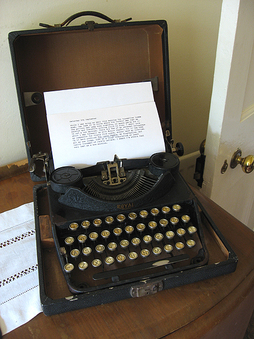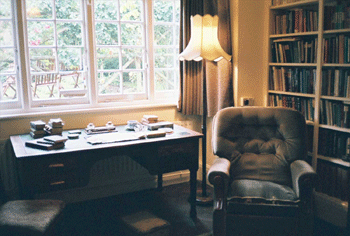 I am always fascinated by the physical ways that people write, by the technologies they choose or don't choose. There is a Royal typewriter at the Kilns, but C. S. Lewis never used it. In fact, he never learned to type at all. He wrote long hand in school exercise books and used an ink-pen that he had to dip in an inkwell--very messy and impractical. Apparently Mr.s Moore hated the inkwell, which he sometimes knocked over and spilled. But stopping to dip the pen in the well was an important part of his writing rhythm. It forced him to pause. In those pauses, he gathered his thoughts, he read the words out loud to himself (and he could hear the words without the interference of tip tapping) and he did recursive editing in his head. Lewis wrote quickly and usually did not take things through a second draft. The ink pen was the only thing that slowed him down. In this way he was the opposite of Tolkien, who composed very slowly, wrote multiple drafts and typed and retyped them himself often to save money. Overwhelmed with the expenses of having a family, he couldn't afford to pay a typist. Of course, Jack's typist was very conveniently his brother Warnie. As an army Officer in Charge of Supplies Warnie would have had to spend many hours in front of a typewriter, filling out forms. He apparently typed very fast although he only used two fingers. And he believed wholeheartedly in his brother and his genius. Typing Jack's papers and correspondence gave him a purpose and was much more fulfilling than typing forms for the army. In addition to never learning to type, Jack never learned how to drive. The scenes of him diving in Shadowlands are pure Hollywood. He loved to walk. He often walked all the way home to Headington from Oxford. He famously became convinced of the truth of Christianity while walking with Tolkien and Hugo Dyson. He took long walking tours with his brother and with other Inklings. On these tours the men would discuss philosophy, religion, and literary criticism. Somehow the movement of their legs, the rhythm of their steps would facilitate the movement of their thoughts. Thought and language are inseparable and rhythm is important to both. The Royal typewriter captures beautifully the relationship between the two brothers. It captures their different personalities; Warnie's more technological bent, his love of machines, boats, train and Jack's literary leanings, his absorption in pre-modern worlds and fantasy. It illustrates their dependence on one another. Warnie needed Jack to keep him away from alcohol, loneliness, depression. Jack needed Warnie to ground him, to remind him of his childhood and to help him type his manuscripts and organize his immense correspondence. NOTES FOR WRITERS AND TEACHERS OF WRITING
First of all, artifacts like the Royal typewriter are great sources of inspiration, great triggers for one's own writing. The Royal typewriter gave me the idea to write a book about C.S. Lewis using the angle of his friendship with his brother. Second of all, it is always good to be aware of the technologies that help us or hurt us while we are writing. What did we use when we first learned to write? What is habitual for us? Does our writing come out differently if we write a draft long hand before transitioning to the typewriter? And when we choose a technology, how much do sound, rhythm and timing matter? Computers give us the ability to compose at lighting speed, but is that always good? Do we loose the sound or sense of what we are writing if we go too fast?
9 Comments
 My editor asked me to do some edits on "Warnie and Jack's Wardrobe," a book about the friendship between C. S. Lewis and his brother Warren Hamilton Lewis. I found myself looking through the letters Jack wrote to Warnie when Warnie was called up for active duty at the beginning of World War 2 in 1939. At this time Warnie would have been 44 years old and Jack 41. One detail that intrigued me was Jack's description of preparing for blackouts to evade German bombs. "The main trouble of life at present is the blacking out which is done (as you may imagine) with a most complicated Arthur Rackham system of odd rags--quite effectively, but at the cost of much labour"(168). When I visited The Kilns with my Guilford students, the tour guides have pointed out the thick blackout curtains in Jack's study. I was also struck by Jack's descriptions of the refugee children. He writes to his brother, "I have said that the children are 'nice,' and so they are. But modern children are poor creatures. They keep on coming to Maureen and asking, 'What shall we do now?' She tells them to play tennis, or mend their stockings, or write home; and when that is done, they come and ask again. Shade of our childhood . . . !" Of course, he and Warnie knew how to occupy themselves building imaginary worlds. I can see in this passage how the presence of children in the house made him think of Little Lea and Boxen and got him started thinking about a whole world behind the old wardrobe. |
Caroline McAlisterCaroline is an avid reader, children's writer, and teacher. She lives in North Carolina with her husband and dog. Check out her bio for more! Archives
February 2024
Categories
All
|
 RSS Feed
RSS Feed